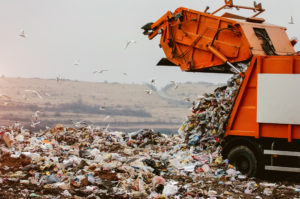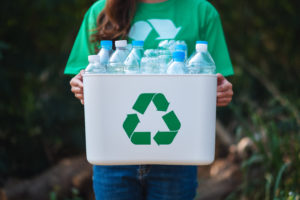Mining is dirty, destructive, and environmentally damaging, but has long been the only way to extract the metals and minerals we consume daily. These materials are used in everything from smartphones to drywall, and as global populations grow, their use grows in tandem.
Our continued reliance on non-renewable resources has been a hot button issue for decades now, with environmentalists highlighting our seemingly insatiable demand for destructive resource gathering and industry leaders citing that the modern world could, simply, not function without these practices. One thing is certain, non-renewable resources are exactly that—a wellspring that will run dry at some point in the future.
Today, in an effort to gain back some of the materials and embodied energy in 21st century products, a variety of interesting solutions have been proposed to deal with existing waste. Among these is the concept of urban mining, a practice that aims to literally pull waste out of landfill and reclaim non-renewable materials to be recycled and reused.
But what exactly is urban mining and is it a viable solution to resource preservation and energy conservation? Here, we look at the pros and cons of an imperfect solution to a self-made problem, and why reuse, reduction, and recycling should always take priority.
What does urban mining mean?

Urban mining is the process of reclaiming raw materials from waste products sent to landfill. On a conceptual level, it looks towards the waste generated by cities and urban environments as a valuable resource, using anthropogenic stocks rather than geological to meet the demands of manufacturing.
It commonly refers to the recovery of metals from e-waste but has been used more generally for the recovery and monetization of any materials from any waste stream, including:
- Construction and Demolition Waste: the recovery of wood, paper, card, rubber, metals, and more.
- Municipal Solid Waste: General recovery which could include everything from re-directing metals and plastics to commercial composting for resale.
- Tires: Specifically, the recovery of rubber and metal from tires and other rubber products.
That said, e-waste is the focus of urban mining since electronics use a range of metals that can be recycled with high rates of recovery, including several precious metals such as gold, silver, and palladium.
How much metal is actually thrown away in the US?

E-waste represents a relatively small part of overall waste in the United States but can have a significant impact when sent to landfills due to the toxicity of some of the elements. In fact, in 2015, the European Chemical Society estimated that 70% of the toxic pollution in landfills could be attributed to e-waste.
What’s more, just because it’s a small part of the overall waste generation figure, it doesn’t mean it’s not significant, with the US generating an estimated 6.92 million tons of e-waste in 2019 and recycling only 15% of it. To put that into a financial context, the value of the materials contained in those electronics is estimated to be around $7.49 billion.
If we look at a single type of e-waste, cell phones, for example, the Environmental Protection Agency estimated that for every million units recycled, one could extract:
- 35 thousand pounds of copper
- 772 pounds of silver
- 75 pounds of gold
- 33 pounds of palladium
A million may seem like a considerable number to recycle, but in 2014, people in the US were already throwing away roughly 416,000 cell phones every single day – that’s more than 150 million a year.
It’s easy to point the finger at new, regularly upgraded electronics like cell phones, but the truth is e-waste come from all kinds of consumer and business sectors, including:
- Large household appliances such as fridges, washing machines, and freezers
- Small household appliances like kettles and microwaves
- IT and telecommunications equipment including old home phones and fax machines
- Electronic tools such as drills
- Toys such as remote control cars
- Leisure and sports equipment
- Medical devices
While it’s always better to avoid creating e-waste in the first place, today’s tech-oriented world makes some degree of waste unavoidable. For example, upgrading electronic medical equipment or other highly advanced electronics is unlikely to be called out by environmentalists as wasteful, while newer industrial electronics may also bring greater efficiencies during manufacturing to cut waste at the source.
If electronics must enter the waste stream, and we agree that it is inevitable that this happens, urban mining could be a solution. Having said that, there are numerous issues surrounding the practice and it must be managed responsibly.
What does urban mining mean for local communities?

While urban mining is positive on the surface, if it isn’t done in a regulated and sustainable way, it can do more harm than good. Much of the e-waste from developed countries such as the US is shipped to landfills in the developing world. Once there, it is often processed by unregulated and unprotected individuals or simply dumped in landfill where independent “urban miners” will scavenge for valuable materials. This leads to a variety of social, environmental, and economic issues.
According to a 2008 report by the World Bank, about 1% of the urban population in developing countries survive by salvaging recyclables from waste. Many of these so-called “waste pickers” come from vulnerable groups, including children, new migrants, the disabled, and the elderly.
They face social stigma and hostility as well as having regular contact with hazardous waste, which is especially harmful to children. It’s important to remember that along with the gold and copper, e-waste contains a whole range of much more dangerous substances that the informal “miners” must sift through, including lead, beryllium, and mercury.
Once the waste is collected by these groups, the valuable metals are often separated from other waste, such as plastic housing, through incineration. In the informal sector, however, there tend to be open fires within the communities that are processing the e-waste.
A study found that this illegal burning of e-waste results in high levels of air pollution, and high levels of exposure to heavy metals in these communities which in turn was “associated with the occurrence of cardiovascular morbidity.” Of course, beyond the immediate health impacts on the local community, this air pollution has a negative impact on the environment.
The issues aren’t only in developing countries, however. The informal sector in higher-income countries often illegally strip high-value items or materials from e-waste, which deprives official recycling channels of the margins they require to operate.
That said, when urban mining is done responsibly, the reclamation and recycling of e-waste can reduce energy consumption, lessen the need to extract virgin resources, and bring money and jobs to the communities that process these materials. Today, urban mining is seen as a viable resource for materials that are either hard or expensive to extract, and many companies are now exploring ways to improve facilities and processes to reduce environmental and human costs associated with the practice.
It’s estimated, for example, that a ton of circuit boards can hold 40 to 800 times more gold, and 30 to 40 times more copper than a metric ton of ore. The amount of recycling waste processed domestically has already increased since China’s 2018 “National Sword” policy, but instead of being a burden, this could lead to the creation of safe, responsible urban mining jobs as cities and states switch to more sustainable waste management.
Urban mining and the three Rs

Today, as the world finally begins to face up to the environmental implications of our existing systems, waste generation and management are increasingly important, allowing us to optimize existing resources and energy, while also reducing the need for landfills or incineration.
In this context, urban mining may seem like a viable solution to existing waste simply rotting in landfill. However, it does not address the root of the problem—a shockingly wasteful system that prioritizes “single-use” products without reference to the three Rs—reducing, reusing, and recycling.
Today, e-waste (and other waste streams) management must begin at the production level, prioritizing the following:
- Reduction – Minimizing waste by designing better products that use less non-renewable resources and energy, that last longer, and that can be easily repaired.
- Reuse – Better products that last longer will enable reuse through second-hand markets. This is preferable to recycling.
- Recycle – As the final piece of the puzzle, recycling e-waste effectively requires a variety of initiatives, including:
- Electronics and other waste streams must be recycled using responsible vendors (RT + E-Steward Certified) to ensure valuable metals are extracted responsibly and remain within the US and not shipped off to 3rd world countries.
- Better enforcement, through legislation and monitoring, across the country to ensure commercial businesses are recycling their electronic waste and not trashing it.
- Local programs rolled out throughout the country to make it easy and convenient for residents and businesses to drop off electronic waste and other materials to certified collection sites.
- More comprehensive EPR programs that hold corporations accountable for the waste they produce. Enforcement ensuring companies take back waste and recycle or dispose of it properly, so the consumer isn’t left with the burden of throwing material away or finding a way to recycle it themselves.
Urban mining as a solution to e-waste presents multiple issues as it is currently being practiced. However, as individuals, businesses, cities, and states begin to switch to zero waste, we are likely to see an increase in circular ways to manage these types of resources.
Today, for example, there are landfills and transfer stations that offer some level of sorting prior to waste being dumped, serving a similar function to urban mining—extracting valuable materials from waste before it is buried in a landfill. Like urban mining, these mechanisms are serving an important purpose in dealing with existing waste, however, they should only be a stopgap as we improve global systems in an effort to keep electronics, and the contained resources, in the loop for as long as possible.
For more information on e-waste and dealing with it as a business, contact one of our TRUE Advisors today. Additionally, subscribe to the RTS blog for more news and insights on waste management and sustainability.

